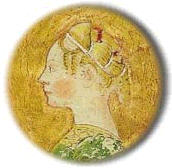Parisina and the cards
|
Parisina (Laura) Malatesta arrived as 14-years-old girl (1418) at the court of Ferrara as bride of the
rather old Signore (35) of Ferrara Niccolo d'Este.
The youth of the bride, the great difference in age to the male husband, were not uncommon at that time, many examples are known.
Filippo Maria Visconti, 36 years in 1428, married Maria of Savoyen (17), Francesco Sforza (40), in concurrence to Lionello
(35) married Bianca Maria (16) in 1441 and Ludovico Sforza (42) married Bianca d'Este (15), which might serve as examples.
It was Niccolo's (* 1383) second marriage, his first wife Gigliola da Carrara (* ca. 1382) stayed childless and died in 1416
of the plague. Niccolo, himself an illegitime son, started to produce sons outside of his marriage with Ugo (1405), Lionello
(1407), Borso (1413) and others following. Parisina got two daughters (1419, twins) and a son (1421), who died after a few weeks. Perhaps the dead son (1421) attacked her health, no children followed till 1425, also we perceive Niccolo again with an illegitimate daughter in 1425 - perhaps the hot love between older husband and young wife got a little colder in the follwing years and caused the desaster in May 1425. Ginevra, *1419; m.1440 Sigismondo Pandolfo Malatesta (possibly killed by her husband) Luzia, *24.3.1419, +28.6.1437; m.1437 Carlo Gonzaga, Signore di Sabbioneta (+21.12.1450) Alberto Carlo, *1421, +aged 21 days Any legal surviving son of Parisina would've attacked the chances of Ugo (* 1405), the oldest of the illegitimes sons of Niccolo, to become Signore at Ferrara. It is reported, that first Ugo reacted with antipathy towards Parisina, who reduced his own chances and the rights of his mother. Other reports believe in a strong antipathy against Ugo at Parisina's side. Card history knows Parisina from 3 documents, which means, that most of the early card documents of Ferrara are related to Parisina.
Around that time San Bernardino was active in Northern Italy, preaching with large success against card playing and other signs of moral decay, especially known from Bologna 1423. It is possible, that his actions were used as background for Niccolo's harsh operation. After the Parisina affair the notes about playing cards in Ferrara took a pause - probably a shock has met the happy court society and it took some time to recover (playing cards in Ferrara are first mentioned in 1334 again, they are imported from Florence and not made in a local production). Niccolo - it is said, that he also took some time at the card table - is known as a good chess-player, perhaps he took more interest in serious games (as known from other great contemporary men, Cosimo di Medici, Filippo Maria Visconti) and the early entries about playing cards in Ferrara might refer only to an older man's interest to amuse his young bride. The 2 daughters of Parisina died early. The first, Luzia, in 1437, very short after her marriage (reasons unknown). The second, Ginevra, in 1440, short after her marriage to Sigismondo Malatesta. It is said, that she was killed by her husband. Sigismondo married an illegitime daughter of Francesco Sforza, Drusiana, which was killed by him in 1449. Sigismondo was accused to be the most worst man of his time, but it was difficult to attack him. Actually one might assume that the murderous act against family members took a horrible influence on the other family members - that's our normal understanding in "modern" psychology. The people in 15th century - and especially the highstanding Lords and Dukes - are often considered by historians made of another stuff - just as they know by their data, that it happened often. But we know - for instance from alcoholism - that "special qualities" are transported in families from generation to generation. Some believe here in a "genetic" reality, which causes the effect. In the following we will have open eyes for the context of Parisinas death - what it caused, what was before, what was the soul of the actions, which appear in time as single spots of unconnected entries in history books. |
 |